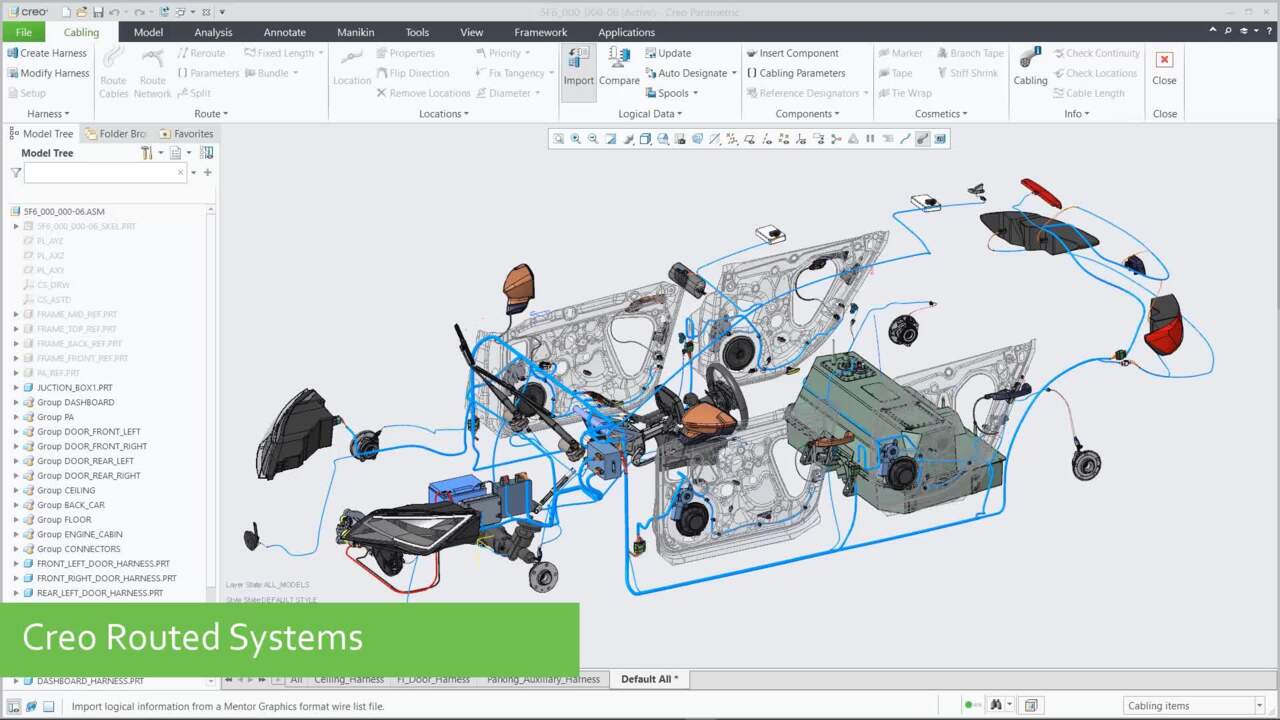
Introduction: PTC Creo, formerly known as Pro/ENGINEER, is a leading computer-aided design (CAD) software used by engineers, designers, and manufacturers to create, analyze, and visualize 3D models of mechanical components and assemblies. With its robust feature set, parametric modeling capabilities, and advanced simulation tools, PTC Creo enables users to design complex products and iterate on designs efficiently. In this extensive guide, we’ll explore the intricacies of using PTC Creo for CAD modeling, covering everything from basic sketching to advanced assembly design and simulation.
Section 1: Getting Started with PTC Creo 1.1 Introduction to CAD Modeling: Gain insight into the fundamentals of CAD modeling and its importance in product design and development. Understand the role of CAD software like PTC Creo in creating digital representations of physical objects, enabling engineers and designers to visualize, analyze, and refine designs before manufacturing. Explore the benefits of parametric modeling techniques for maintaining design intent, associativity, and design history in CAD models.
1.2 Installing PTC Creo and Setting up the Workspace: Before you can start CAD modeling with PTC Creo, you’ll need to download and install the software on your computer. PTC Creo is available for Windows and Linux platforms and can be obtained from the PTC website. Launch PTC Creo and familiarize yourself with the user interface, including the ribbon toolbar, model tree, graphics window, and command manager, where you’ll create and manipulate CAD models.
Section 2: Basic CAD Modeling Techniques 2.1 Sketching and Creating Features: Start CAD modeling in PTC Creo by sketching 2D profiles and extruding them into 3D features. Learn how to create sketch planes, draw lines, arcs, circles, and other geometric entities in the sketcher environment. Use sketch constraints and dimensions to define the size, shape, and position of sketch elements accurately. Extrude, revolve, sweep, and loft sketches to create basic features such as extrusions, revolves, sweeps, and lofts in 3D space.
2.2 Modifying and Editing Features: Explore techniques for modifying and editing CAD features in PTC Creo to refine and optimize designs. Learn how to modify feature dimensions, parameters, and constraints to adjust the size, shape, and position of features interactively. Use direct modeling tools such as move, rotate, scale, and offset to manipulate geometry directly without affecting parametric relationships. Employ feature editing tools such as fillet, chamfer, hole, and pattern to add detail and complexity to CAD models.
Section 3: Advanced CAD Modeling Techniques 3.1 Creating Advanced Features: Advance your CAD modeling skills in PTC Creo by creating complex features and geometry. Learn how to create advanced features such as blends, drafts, ribs, shells, and sweeps using specialized modeling tools and techniques. Experiment with feature creation options such as variable section sweeps, thin wall extrusions, and user-defined features to achieve desired design outcomes. Combine multiple features and feature types to model intricate geometries and organic shapes effectively.
3.2 Assembling Components and Assemblies: Explore techniques for assembling components and creating assemblies in PTC Creo to model complex mechanical systems. Learn how to import component models, assemble them into assemblies, and define assembly constraints such as mates, contacts, and alignments. Use assembly features such as exploded views, interference detection, and assembly analysis tools to evaluate assembly performance and resolve design conflicts. Manage assembly structures, configurations, and relationships to organize and maintain large assembly models efficiently.
Section 4: Analyzing and Validating Designs 4.1 Performing Simulation and Analysis: Utilize PTC Creo’s simulation and analysis tools to evaluate and validate CAD designs for performance and functionality. Learn how to perform structural analysis, thermal analysis, and motion analysis on CAD models to assess factors such as stress, deformation, temperature distribution, and kinematic behavior. Interpret simulation results, identify design weaknesses, and make informed design decisions to optimize product performance and reliability.
4.2 Checking and Verifying Designs: Ensure the integrity and manufacturability of CAD designs in PTC Creo by performing design checks and verification procedures. Use design validation tools such as interference checking, clearance analysis, and tolerance analysis to detect and resolve design errors and inconsistencies. Validate designs against engineering standards, manufacturing constraints, and design specifications to ensure compliance and adherence to design requirements.
Section 5: Documenting and Communicating Designs 5.1 Creating Drawings and Documentation: Generate detailed engineering drawings and documentation from CAD models in PTC Creo to communicate design intent and specifications. Learn how to create 2D drawings, views, dimensions, and annotations directly from 3D models using drawing templates and standards. Customize drawing layouts, title blocks, and annotation styles to conform to company standards and industry practices. Export drawings to standard file formats such as PDF, DWG, and DXF for sharing and collaboration with stakeholders.
5.2 Collaborating and Sharing Designs: Collaborate with team members and stakeholders by sharing CAD models, assemblies, and drawings in PTC Creo. Learn how to manage design data, revisions, and version control using PTC Windchill, PTC Creo’s integrated product lifecycle management (PLM) system. Share design files securely over network drives, cloud storage, or collaboration platforms, and track changes and comments using revision control and markup tools. Facilitate communication and collaboration among team members to streamline the design process and ensure project success.
Conclusion: PTC Creo is a powerful CAD modeling software that empowers engineers and designers to create innovative products and solutions efficiently. By mastering the fundamentals of CAD modeling in PTC Creo and exploring advanced techniques for feature creation, assembly design, simulation, and documentation, you can unleash your creativity and design expertise to tackle complex engineering challenges with confidence. Whether you’re designing consumer products, industrial machinery, or automotive components, PTC Creo provides the tools and capabilities you need to bring your ideas to life and drive innovation in the digital age. With practice, experimentation, and continuous learning, you can become proficient in using PTC Creo to realize your design vision and achieve excellence in product development and engineering design.